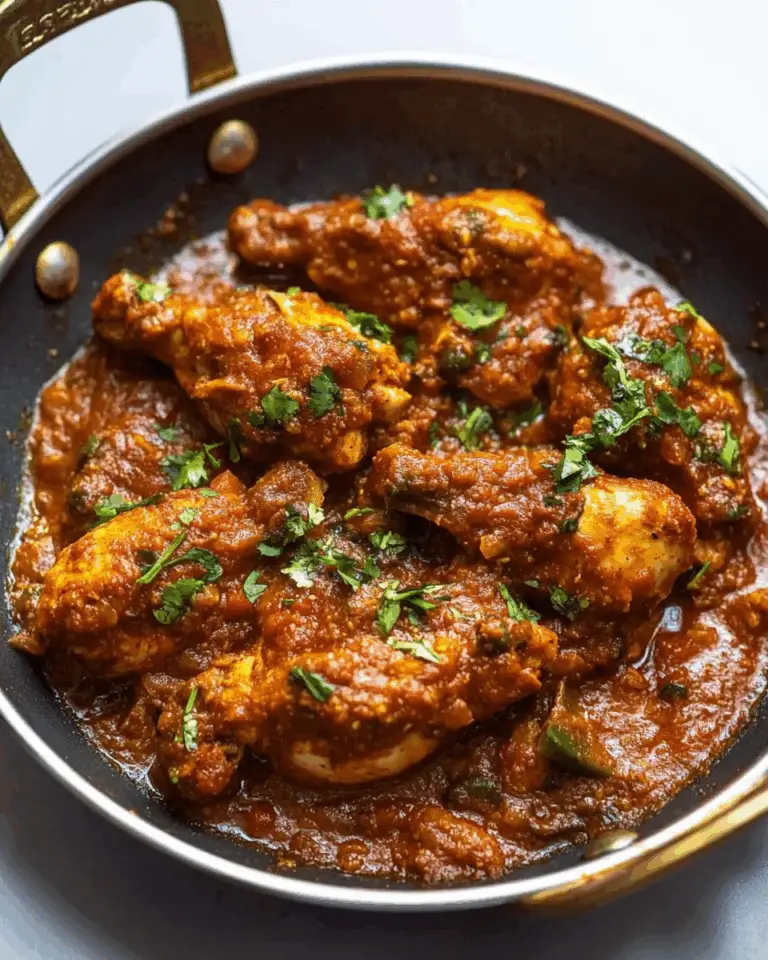This Chicken Bhuna is a classic Indian comfort dish. Known for its rich, thick masala coating and balanced heat, it’s perfect for chilly evenings. This easy-to-follow recipe yields a deeply flavorful dish that pairs wonderfully with basmati rice or homemade roti.
Full Recipe:
Ingredients
-
6 chicken thighs, boneless and skinless, diced into 1-inch chunks
-
4 garlic cloves, peeled and chopped
-
1 green chilli, deseeded and chopped
-
2 tbsp ginger, chopped
-
2 onions, diced
-
1 tsp turmeric powder
-
2 tsp chilli powder
-
2 tsp ground cumin
-
2 tsp ground coriander
-
1 tsp garam masala
-
5 tomatoes, chopped
-
1/2 tsp lemon juice
-
1 tbsp coriander, chopped
-
3 tbsp vegetable oil
-
Salt, to taste
Directions
-
Heat oil in a deep frying pan or wok. Add garlic, green chilli, and ginger. Sauté for 1 minute.
-
Add the chopped onions and cook over medium heat for 3–4 minutes until golden brown.
-
Stir in turmeric, chilli, cumin, coriander, and garam masala. Cook for 1 minute.
-
Add chopped tomatoes, 100ml water, and a pinch of salt. Cover and let it boil, stirring occasionally, until the masala thickens.
-
Add chicken, coating it well in the thick masala. Cook over medium heat for 20 minutes, stirring occasionally, until chicken is tender.
-
Finish with lemon juice and garnish with chopped coriander before serving.
Nutrients (estimated per serving)
-
Calories: ~350 kcal
-
Protein: ~30g
-
Fat: ~20g
-
Carbohydrates: ~10g
-
Fiber: ~3g
-
Sodium
Overview of Chicken Bhuna
Chicken Bhuna is the kind of dish that instantly warms the soul. Its name comes from the Hindi-Urdu word for “to be fried,” pointing to the technique of slow-frying spices and aromatics until they release their essential oils and cling to the chicken in a luxurious, thick masala. What distinguishes this recipe from everyday curries is the ratio of sauce to meat: unlike saucier preparations, Bhuna masala cooks down to a rich coating that hugs each bite. The result is a concentrated flavor bomb—aromatic, lightly smoky, and layered with gentle heat—that feels tailor-made for chilly evenings. When Michelin-starred chef Peter Joseph puts his stamp on the classic, he retains its comforting core while refining the balance of spices so that no single note overwhelms. One taste makes it clear why the dish has moved beyond regional roots to become a global favorite among home cooks and fine-dining patrons alike.
Mastering the Bhuna Technique
At the heart of this recipe lies the bhuna method, a patient process that elevates modest pantry staples into a deeply flavored masala. Spices are first bloomed in hot oil, allowing their fat-soluble compounds to dissolve and perfume the kitchen. Onions then caramelize slowly, lending natural sweetness that tempers the heat of green chilli, ginger, and powdered spices. Tomatoes arrive next, their moisture coaxing the browned mixture into a thick sauce that will later reduce to an almost jam-like glaze. Only after this foundation is perfected does the chicken enter the pan, simmering gently until every cube is lacquered in spice. Because the liquid is minimal, the meat essentially braises in its own juices, concentrating flavor while remaining succulent. The final texture should be neither runny nor dry—just a glossy masala that clings to the spoon in soft, fragrant ribbons.
Aroma and Flavor Symphony
Chicken Bhuna tastes like an orchestra of well-tuned spices. Turmeric lends earthiness and a burnished amber hue, while chilli powder and fresh green chilli deliver a layered heat that builds without scorching the palate. Ground cumin and coriander supply toasty, citrus-like undertones that keep the dish from feeling heavy. Garam masala, added during the sauté rather than at the end, infuses the whole sauce with warm notes of clove, cinnamon, and black cardamom. Ginger provides a peppery zing, and garlic rounds everything out with savory depth. As the masala reduces, tomatoes break down into sweetness, marrying all the spices into a coherent whole. The last-minute splash of lemon brightens the finish, and fresh coriander leaves add a herbal pop. Every bite reveals a different nuance—first a gentle warmth, then a fragrant sweetness, finally a subtle smoky linger—that invites you back for another spoonful.
Serving and Pairing Suggestions
Tradition suggests tucking into Chicken Bhuna with steamed basmati rice, whose long, airy grains soak up the concentrated masala without stealing the spotlight. Yet homemade roti or flaky paratha can be equally satisfying; their chewy surfaces mop up every last drop of sauce. For textural contrast, consider serving crisp pappadums or a simple cucumber-onion salad dressed with lemon and black salt. Because Bhuna carries moderate heat, a cooling raita—yogurt mixed with grated cucumber and mint—offers balance. Beverage pairings can range from a lightly hopped lager, which mirrors the dish’s spice without bitterness, to a fruity off-dry Riesling that complements the tomato and ginger notes. If you prefer non-alcoholic options, a chilled mango lassi or masala chai with a touch of jaggery provides a harmonious, palate-soothing finale.
Nutritional and Health Insights
Despite its indulgent taste, Chicken Bhuna can fit comfortably into a balanced diet. Each serving delivers roughly 30 grams of high-quality protein, essential for muscle repair and satiety. Using skinless chicken thighs strikes a smart compromise between tenderness and moderate fat, providing about 20 grams of mostly monounsaturated and polyunsaturated fats. At around 350 calories per portion, the dish remains approachable for those mindful of energy intake. The spice blend carries antioxidant-rich compounds: curcumin from turmeric is celebrated for anti-inflammatory potential, while the capsaicin in chilli may aid metabolism. Garlic and ginger contribute allicin and gingerol, known for supporting cardiovascular health and digestion. Because the masala calls for minimal added water and no cream, the carbohydrate load stays low—roughly 10 grams—making the meal suitable for lower-carb lifestyles when paired with cauliflower rice or lettuce wraps. A moderate sodium content means you can enjoy full flavor without excessive salt.
Cultural Resonance and Modern Appeal
Bhuna dishes trace their origins to the eastern regions of the Indian subcontinent, where cooks adapted to humid climates by reducing curries into thicker gravies that kept longer and traveled well. Over centuries, the technique migrated across India and eventually overseas through diaspora communities. In the United Kingdom, Chicken Bhuna has become a beloved staple on curry-house menus, prized for its boldness yet familiarity. Today, social media and televised cooking competitions have introduced the recipe to a new generation eager for authentic flavors that fit busy schedules. Chef Peter Joseph’s version exemplifies this evolution: rooted in memory, refined for modern kitchens, and easily scaled for weeknight dinners or celebratory spreads. Its enduring popularity underscores a universal truth—well-balanced spices and comforting textures transcend borders, bringing people together at the table.
Conclusion
Chicken Bhuna by Michelin-starred chef Peter Joseph is more than a recipe; it is a culinary narrative that weaves tradition, technique, and innovation into one memorable dish. The meticulous bhuna process transforms humble ingredients into a masala so rich and nuanced that each bite tells a story of centuries-old spice routes and contemporary fine-dining finesse. Whether ladled over fragrant basmati rice or scooped up with warm roti, the dish offers an experience that is at once deeply comforting and pleasantly exciting. Beyond its captivating taste, Chicken Bhuna provides meaningful nutrition and showcases the health-forward benefits of spices long celebrated in Ayurvedic wisdom. It invites novice cooks to explore the art of controlled caramelization and encourages seasoned chefs to appreciate the subtle power of balance. Ultimately, this Bhuna stands as a testament to the timeless appeal of Indian cuisine—bold yet harmonious, steeped in heritage yet endlessly adaptable, and guaranteed to leave an indelible impression on anyone fortunate enough to savor it.






